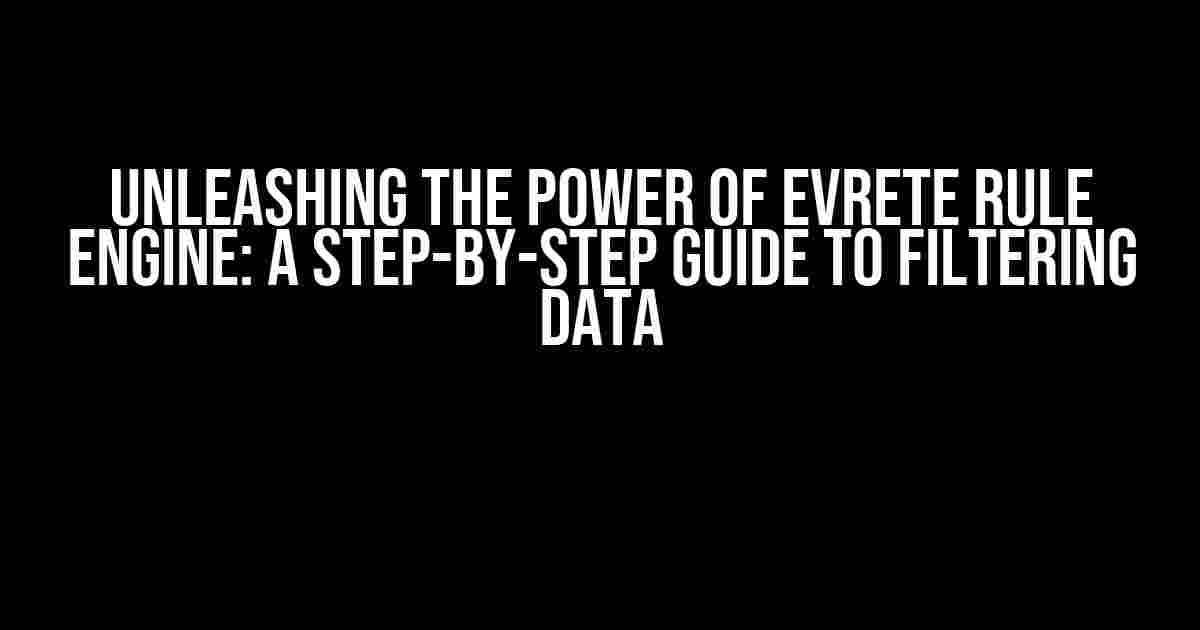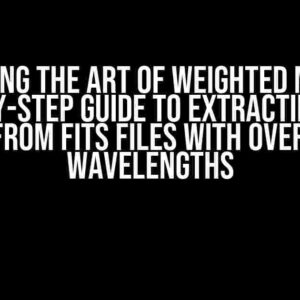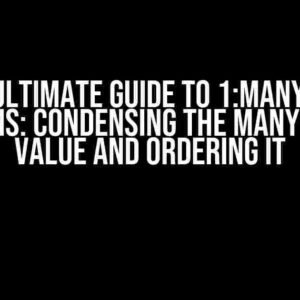Welcome to the world of Evrete Rule Engine, where data filtering becomes a breeze! In this comprehensive guide, we’ll take you on a journey to master the art of filtering data using this powerful tool. Whether you’re a seasoned developer or a newbie, this article will provide you with clear instructions and explanations to get you started.
What is Evrete Rule Engine?
Before we dive into the nitty-gritty of filtering data, let’s take a brief look at what Evrete Rule Engine is all about. Evrete Rule Engine is a robust and flexible business rules management system that enables you to define, execute, and manage complex business rules. With its intuitive interface and powerful features, it’s the perfect tool for automating decision-making processes and streamlining your data filtering needs.
Why Filter Data with Evrete Rule Engine?
So, why should you choose Evrete Rule Engine for filtering your data? Here are just a few compelling reasons:
- Flexibility**: Evrete Rule Engine provides an incredibly flexible framework for defining and executing complex rules, making it the perfect choice for filtering data.
- Scalability**: Whether you’re dealing with a small dataset or a massive one, Evrete Rule Engine can handle it with ease, ensuring your data filtering needs are met with precision and speed.
- Ease of Use**: With its intuitive interface and drag-and-drop functionality, Evrete Rule Engine makes it easy for anyone to create and execute complex rules, regardless of their technical expertise.
Preparing Your Data for Filtering
Before you start filtering your data, it’s essential to prepare it for processing. Here are the steps to follow:
- Import Your Data**: Import your data into Evrete Rule Engine using its built-in data import features or APIs.
- Define Your Data Model**: Define your data model by creating entities, attributes, and relationships. This will help you to understand the structure of your data and create effective rules.
- Clean and Normalize Your Data**: Clean and normalize your data to ensure it’s free from errors and inconsistencies.
Creating a Rule for Filtering Data
Now that your data is prepared, it’s time to create a rule for filtering. Here’s a step-by-step guide:
- Create a New Rule**: Create a new rule in Evrete Rule Engine by clicking on the “Create Rule” button.
- Define the Rule Name and Description**: Give your rule a name and description to help you identify its purpose.
- Define the Condition**: Define the condition for filtering your data using the drag-and-drop interface. For example, you can create a condition like “Age > 18” or “Country = ‘USA'”.
- Define the Action**: Define the action to be taken when the condition is met. For example, you can create an action like “Filter out rows that don’t meet the condition”.
- Save and Test the Rule**: Save the rule and test it using sample data to ensure it’s working as expected.
Advanced Filtering Techniques
Now that you’ve learned the basics of filtering data using Evrete Rule Engine, let’s take it to the next level with some advanced techniques:
Using Logical Operators
Evrrete Rule Engine supports a range of logical operators that enable you to create complex conditions for filtering data. Here are some examples:
// Using AND operator
Condition: Age > 18 AND Country = 'USA'
// Using OR operator
Condition: Age > 18 OR Age < 30
// Using NOT operator
Condition: NOT (Country = 'USA')
Using Functions and Macros
Evrrete Rule Engine provides a range of built-in functions and macros that can be used to create more complex conditions for filtering data. Here are some examples:
// Using the LENGTH function
Condition: LENGTH(Name) > 5
// Using the CONTAINS macro
Condition: CONTAINS(Description, 'keyword')
// Using the DATE_PART function
Condition: DATE_PART(Birthdate, 'year') > 1990
Using External Data Sources
Evrrete Rule Engine allows you to use external data sources to filter your data. Here's an example:
// Using an external database
Condition: EXISTS (SELECT 1 FROM external_database WHERE CustomerID = CustomerID)
// Using a web service
Condition: WEB_SERVICE('https://example.com/api/customer eligibility', CustomerID) = 'true'
Best Practices for Filtering Data with Evrete Rule Engine
To get the most out of Evrete Rule Engine's filtering capabilities, follow these best practices:
- Keep it Simple**: Keep your rules simple and focused on a specific task to ensure they're easy to maintain and debug.
- Use Meaningful Names**: Use meaningful names for your rules, conditions, and actions to make them easy to understand.
- Test Thoroughly**: Test your rules thoroughly using sample data to ensure they're working as expected.
- Optimize Performance**: Optimize your rules for performance by minimizing the number of conditions and actions.
Conclusion
And there you have it – a comprehensive guide to filtering data using Evrete Rule Engine! With its powerful features and intuitive interface, Evrete Rule Engine makes it easy to filter your data with precision and speed. By following the steps and best practices outlined in this article, you'll be well on your way to mastering the art of data filtering using Evrete Rule Engine.
| Keyword | Description |
|---|---|
| Filtering Data | The process of selecting specific data from a larger dataset based on certain criteria. |
| Evrrete Rule Engine | A business rules management system that enables you to define, execute, and manage complex business rules. |
| Condition | A set of criteria used to filter data, such as "Age > 18" or "Country = 'USA'". |
| Action | A task to be performed when a condition is met, such as "Filter out rows that don't meet the condition". |
By mastering the art of filtering data using Evrete Rule Engine, you'll be able to make more informed decisions, automate complex processes, and unlock the full potential of your data. So, what are you waiting for? Start filtering your data today!
Frequently Asked Question
Get ready to unlock the power of data filtering with Evrete Rule Engine! Here are some frequently asked questions to help you get started.
What is Evrete Rule Engine and how does it help with data filtering?
Evrrete Rule Engine is a powerful tool that allows you to create custom rules to filter and manipulate your data. It uses a simple, intuitive syntax to define conditions and actions, making it easy to extract the insights you need from your data.
How do I create a rule in Evrete Rule Engine to filter my data?
To create a rule in Evrete Rule Engine, simply define a condition and an action. For example, you might create a rule that says "IF the value of column A is greater than 10, THEN filter out the row". You can then apply this rule to your data to extract only the rows that meet the condition.
Can I use multiple conditions in a single rule to filter my data?
Yes, absolutely! Evrete Rule Engine allows you to use multiple conditions in a single rule, making it easy to filter your data based on complex criteria. You can use logical operators like AND and OR to combine conditions and create powerful filters.
How do I apply a rule to my data in Evrete Rule Engine?
To apply a rule to your data, simply select the rule you want to use and click "Apply". Evrete Rule Engine will then filter your data according to the conditions defined in the rule, and display the results in a new table.
Can I save my rules in Evrete Rule Engine for later use?
Yes, you can save your rules in Evrete Rule Engine for later use. This allows you to reuse your rules across different datasets and projects, and share them with others if needed.



